Netty的基本使用
一、NIO基础
BIO
Blocking IO: 同步阻塞的编程方式。
JDK1.4版本提供了BIO编程方式。编程实现过程为:首先在服务端启动一个ServerSocket来监听网络请求,客户端启动Socket发起网络请求,默认情况下ServerSocket回建立一个线程来处理此请求,如果服务端没有线程可用,客户端则会阻塞等待或遭到拒绝。通讯过程中,是同步的。在并发处理效率上比较低。
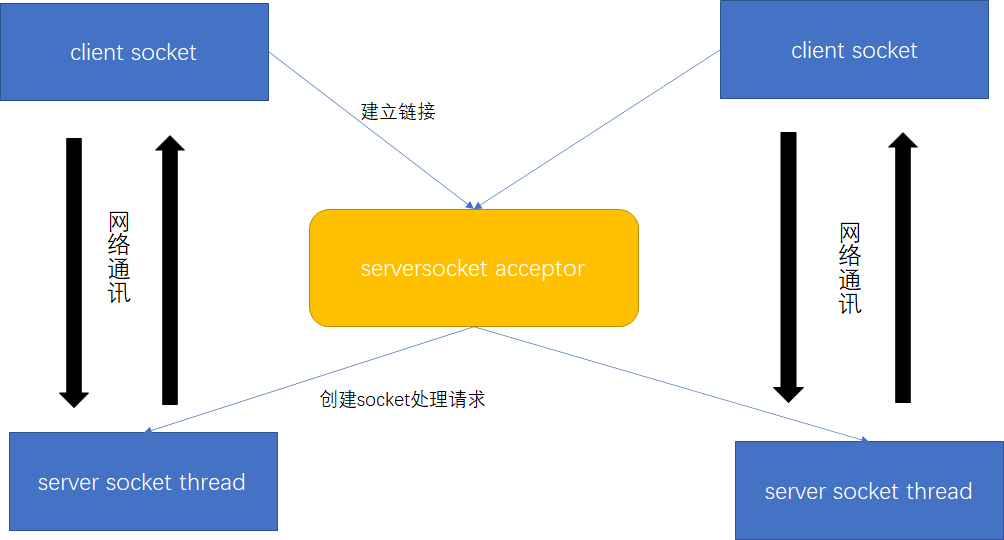
同步并阻塞,服务器实现模式为一个连接一个线程,即客户端有连接请求时服务器端就需要启动一个线程进行处理,如果这个连接不做任何事情会造成不必要的线程开销,当然可以通过线程池机制改善。BIO方式适用于连接数目比较小且固定的架构,这种方式对服务器资源要求比较高,并发局限于应用中,JDK1.4以前的唯一选择,但程序直观简单易理解。
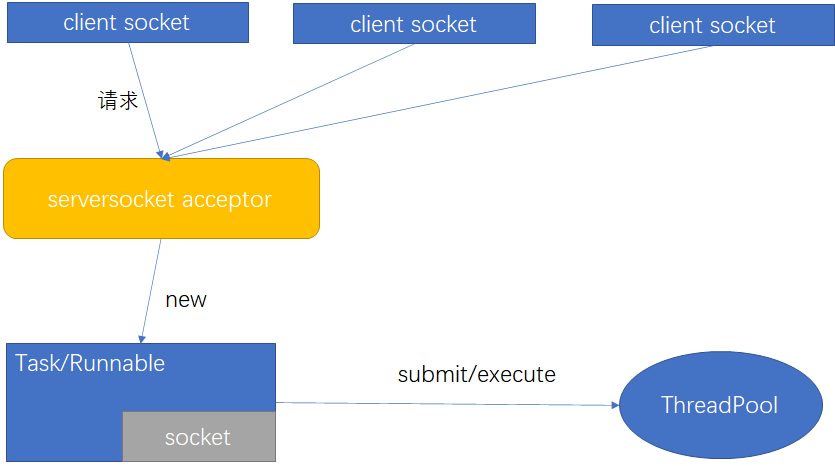
NIO
Unblocking IO(New IO): 同步非阻塞的编程方式。
NIO本身是基于事件驱动思想来完成的,其主要想解决的是BIO的大并发问题,NIO基于Reactor,当socket有流可读或可写入socket时,操作系统会相应的通知引用程序进行处理,应用再将流读取到缓冲区或写入操作系统。也就是说,这个时候,已经不是一个连接就要对应一个处理线程了,而是有效的请求,对应一个线程,当连接没有数据时,是没有工作线程来处理的。
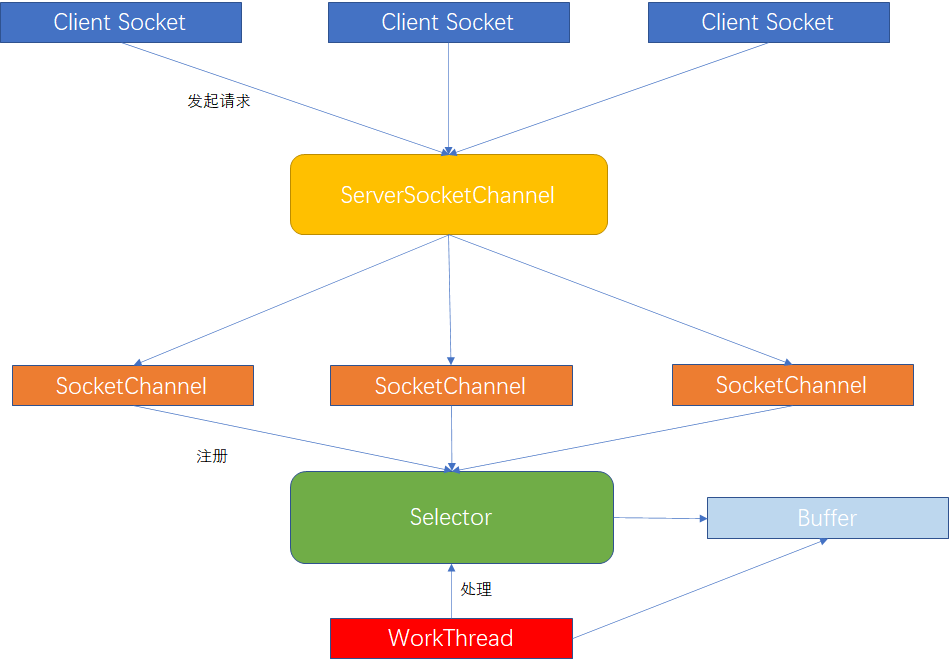
NIO - 三大组件
Channel & Buffer
channel有一点类似于stream,它就是读写数据的双向通道,可以从channel将数据读入buffer,也可以将buffer的数据写入channel,而之前的stream要么是输入,要么是输出,channel比stream更为底层

常见的Channel:FileChannel【File】、DatagramChannel【UDP】、SocketChannel【TCP】、ServerSocketChannel【TCP】
buffer用来缓冲读写数据,常见的buffer:MappedByteBuffer【内存映射文件】、DirectByteBuffer【直接内存分配】、HeapByteBuffer【堆内存】
Selector
selector的作用就是配合一个线程来管理多个channel,获取这些channel上发生的事件。这些channel工作在非阻塞模式下,适合连接数特别多,但流量低的场景。调用selector的select()会阻塞直到channel发生了读写就绪事件,当事件发生select方法就会返回这些事件交给thread来处理
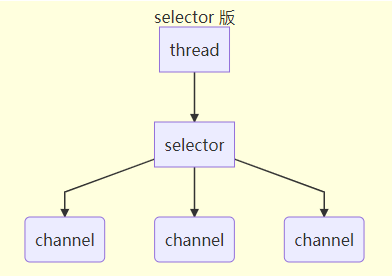
NIO - ByteBuffer
ByteBuffer 正确使用姿势
- 向buffer写入数据,例如调用channel.read(buffer)
- 调用flip()切换至读模式
- 从 buffer 读取数据,例如调用 buffer.get()
- 调用 clear() 或 compact() 切换至写模式
- 重复 1~4 步骤
用buyteBuffer读取文件数据示例
@Test
public void testByteBuffer() throws Exception {
RandomAccessFile file = new RandomAccessFile("data.txt", "rw");
FileChannel channel = file.getChannel();
ByteBuffer buffer = ByteBuffer.allocate(10);
int readLen = 0;
do {
// 向 buffer 写入
readLen = channel.read(buffer);
log.info("读取到字节 {}",readLen);
// 切换 buffer 读模式
buffer.flip();
while (buffer.hasRemaining()) {
log.info("{}", (char) buffer.get());
}
// 切换 buffer 写模式
buffer.clear();
} while (readLen != -1);
}
ByteBuffer结构
ByteBuffer的重要属性:capacity【容量】、position【读写位置】、limit【读写限制位置】
初始时
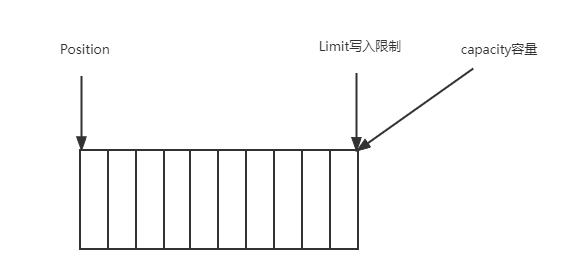
写模式下,position是写入位置,limit等于容量(含义是可写入的最大限制)
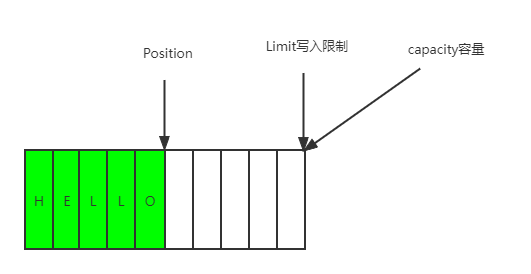
flip动作发生后,position切换为读取位置,limit切换为读取限制
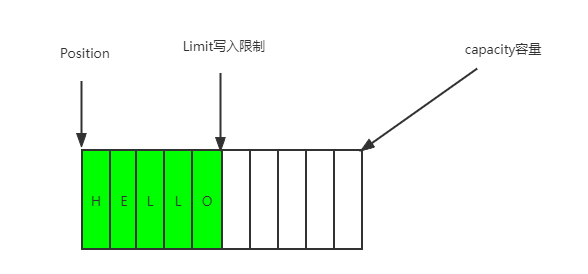
clear动作发生后,会将position置为0,limit置为capacity位置,但是数据块不会重置
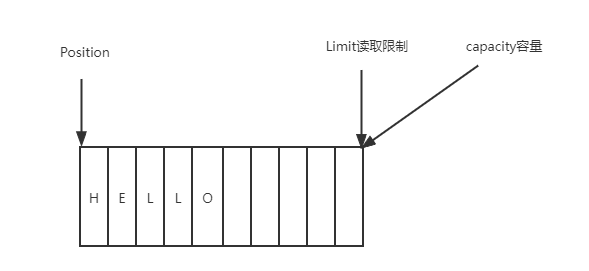
compact方法,是把未读完的部分向前压缩,然后切换至写模式
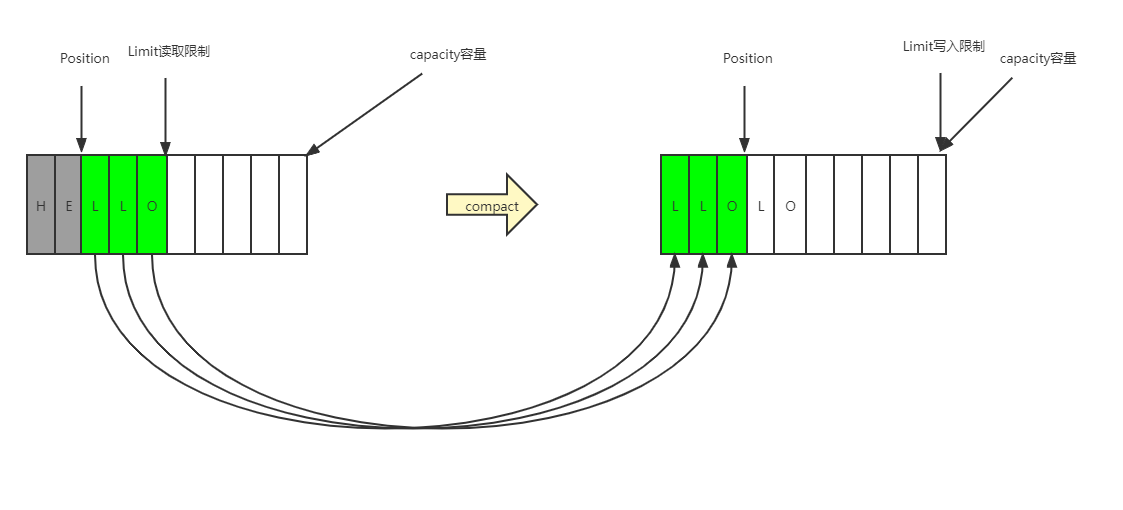
NIO - ByteBuffer 常见方法
- 分配空间
// heap 内存
ByteBuffer buf = ByteBuffer.allocate(16);
// 直接内存
ByteBuffer directBuf = ByteBuffer.allocateDirect(16);
- 向buffer写入数据
int readBytes = channel.read(buf); //返回从channel读取的长度
buf.put((byte)127); //手动放入数据
- 从buffer读取数据
int writeBytes = channel.write(buf); // 返回写入到channle的自己数量
byte b = buf.get(); // 手动读取数据,会移动position指针
byte b = buf.get(i); // 手动读取数据,不移动position指针
- 重置读取位置
buf.rewind(); // 重置position为0
/**
* mark & reset
* mark在读取时,做一个标记。即使position改变,只要调用reset就能回到mark的位置
*/
@Test
public void markAndRestTest() {
ByteBuffer buffer = ByteBuffer.allocate(10);
buffer.put("123456".getBytes());
buffer.flip();
byte b1 = buffer.get(); // '1'
buffer.mark();
byte b2 = buffer.get(); // '2'
byte b3 = buffer.get(); // '3'
buffer.reset();
byte hasB2 = buffer.get(); //'2'
assert hasB2 == b2;
}
- 字符串与ByteBuffer互转
// 字符串转ByteBuffer
ByteBuffer buffer1 = StandardCharsets.UTF_8.encode("你好");
debug(buffer1);
// ByteBuffer转字符串
CharBuffer buffer2 = StandardCharsets.UTF_8.decode(buffer1);
System.out.println(buffer2.toString());
- Scattering Reads
// 分散读取,有一个文本文件 3parts.txt 内容 onetwothree
@Test
public void partsReadTest() {
try (RandomAccessFile file = new RandomAccessFile("3parts.txt", "rw")) {
FileChannel channel = file.getChannel();
ByteBuffer a = ByteBuffer.allocate(3);
ByteBuffer b = ByteBuffer.allocate(3);
ByteBuffer c = ByteBuffer.allocate(5);
channel.read(new ByteBuffer[]{a, b, c});
a.flip();
b.flip();
c.flip();
ByteBufferUtil.debugAll(a); //one
ByteBufferUtil.debugAll(b); //two
ByteBufferUtil.debugAll(c); //three
} catch (IOException e) {
e.printStackTrace();
}
}
- Gathering Writes
// 将多个buffer的数据合并写入到一个channel
@Test
public void gatheringWritesTest() {
try (RandomAccessFile file = new RandomAccessFile("2parts.txt", "rw")) {
FileChannel channel = file.getChannel();
ByteBuffer d = ByteBuffer.allocate(4);
ByteBuffer e = ByteBuffer.allocate(4);
d.put(new byte[]{'f', 'o', 'u', 'r'});
e.put(new byte[]{'f', 'i', 'v', 'e'});
d.flip();
e.flip();
channel.write(new ByteBuffer[]{d, e});
} catch (IOException e) {
e.printStackTrace();
}
}
注意:Buffer是非线程安全
NIO - 文件编程
NIO中使用FileChannel建立与文件的链接通道,FileChannel只能工作在阻塞模式下。
获取
可以通过FileChannel.open获取FileChannel,也可通过FileInputStream、FileOutputStream或者RandomAccessFile来获取,它们都有getChannel方法
- 通过FileInputStream获取的channel只能读
- 通过FileOutputStream获取的channel只能写
- 通过RandomAccessFile是否能读写根据构造RandomAccessFile时的读写模式决定
读取
// 会从channel读取数据填充ByteBuffer,返回值表示读到了多少字节,-1表示到达了文件的末尾
int readBytes = channel.read(buffer);
写入
// 正确的写入姿势,如果buffer较大,一次会写不完
while(buffer.hasRemaining()) {
channel.write(buffer);
}
关闭
channel必须关闭,不过调用了FileInputStream、FileOutputStream或者RandomAccessFile的close方法会间接地调用channel的close方法
位置
// 获取当前位置
long pos = channel.position();
/**
* 设置当前位置
* 设置当前位置时,如果设置为文件的末尾
* - 这时读取会返回 -1
* - 这时写入,会追加内容,但要注意如果position超过了文件末尾,再写入时在新内容和原末尾之间会有空洞(00)
*/
channel.position(newPos);
大小
channel.size(); //获取文件大小
强制写入
操作系统出于性能的考虑,会将数据缓存,不是立刻写入磁盘。可以调用force(true) 方法将文件内容和元数据(文件的权限等信息)立刻写入磁盘
两个 Channel 传输数据
public void fileChannelTransferToTest() {
try (
FileChannel from = new FileInputStream("data.txt").getChannel();
FileChannel to = new FileOutputStream("to.txt").getChannel();
) {
// 效率高,底层会利用操作系统的零拷贝进行优化
long size = from.size();
// left 变量代表还剩余多少字节
for (long left = size; left > 0; ) {
System.out.println("position:" + (size - left) + " left:" + left);
left -= from.transferTo((size - left), left, to);
}
} catch (IOException e) {
e.printStackTrace();
}
}
Path
jdk7 引入了Path和Paths类
- Path用来表示文件路径
- Paths是工具类,用来获取Path实例
Path source = Paths.get("1.txt"); // 相对路径使用user.dir环境变量来定位1.txt
Path source = Paths.get("d:\\1.txt"); // 绝对路径代表了d:\1.txt
Path projects = Paths.get("d:\\data", "projects"); // 代表了d:\data\projects
Path path = Paths.get("d:\\data\\projects\\a\\..\\b");
path.normalize() // 计算为d:\data\projects\b
Files
- 检查文件是否存在
Path path = Paths.get("data.txt");
System.out.println(Files.exists(path));
- 创建一级目录
Path path = Paths.get("d1");
Files.createDirectory(path);
- 创建多级目录用
Path path = Paths.get("d1/d2/d3");
Files.createDirectories(path);
- 拷贝文件
Path source = Paths.get("data.txt");
Path target = Paths.get("target.txt");
// 如果文件已存在,会抛异常FileAlreadyExistsException
// 可以使用Files.copy(source, target, StandardCopyOption.REPLACE_EXISTING);
Files.copy(source, target);
- 移动文件
Path source = Paths.get("data.txt");
Path target = Paths.get("data.txt");
// StandardCopyOption.ATOMIC_MOVE 保证文件移动的原子性
Files.move(source, target, StandardCopyOption.ATOMIC_MOVE);
- 删除文件
Path target = Paths.get("target.txt");
Files.delete(target); // 如果文件不存在,会抛异常 NoSuchFileException
- 删除目录
Path target = Paths.get("d1");
Files.delete(target); // 如果目录还有内容,会抛异常 DirectoryNotEmptyException
- 遍历目录文件
@Test
public void loopDirTest() throws Exception {
Path path = Paths.get("C:\\Program Files\\Java\\jdk1.8.0_181");
Files.walkFileTree(path, new SimpleFileVisitor<Path>(){
@Override
public FileVisitResult preVisitDirectory(Path dir, BasicFileAttributes attrs) throws IOException {
log.info("preVisitDirectory dir={}", dir.getFileName());
return super.preVisitDirectory(dir, attrs);
}
@Override
public FileVisitResult visitFile(Path file, BasicFileAttributes attrs) throws IOException {
log.info("visitFile file={}", file.getFileName());
return super.visitFile(file, attrs);
}
@Override
public FileVisitResult visitFileFailed(Path file, IOException exc) throws IOException {
log.info("visitFileFailed file={} exc={}", file.getFileName(), exc.getMessage());
return super.visitFileFailed(file, exc);
}
@Override
public FileVisitResult postVisitDirectory(Path dir, IOException exc) throws IOException {
log.info("postVisitDirectory dir={}", dir.getFileName());
return super.postVisitDirectory(dir, exc);
}
});
}
NIO - 网络编程
非阻塞vs阻塞
阻塞
阻塞模式下,相关方法都会导致线程暂停
- ServerSocketChannel.accept会在没有连接建立时让线程暂停
- SocketChannel.read会在没有数据可读时让线程暂停
- 阻塞的表现其实就是线程暂停了,暂停期间不会占用cpu,但线程相当于闲置
单线程下,阻塞方法之间相互影响,几乎不能正常工作,需要多线程支持
多线程下,有新的问题,体现在以下方面
- 32 位jvm一个线程320k,64位jvm一个线程1024k,如果连接数过多,必然导致OOM,并且线程太多,反而会因为频繁上下文切换导致性能降低
- 可以采用线程池技术来减少线程数和线程上下文切换,但治标不治本,如果有很多连接建立,但长时间inactive,会阻塞线程池中所有线程,因此不适合长连接,只适合短连接
@Test
public void blockIOTest() throws IOException {
// 使用 nio 来理解阻塞模式, 单线程
// 0. ByteBuffer
ByteBuffer buffer = ByteBuffer.allocate(16);
// 1. 创建了服务器
ServerSocketChannel ssc = ServerSocketChannel.open();
// 2. 绑定监听端口
ssc.bind(new InetSocketAddress(8080));
// 3. 连接集合
List<SocketChannel> channels = new ArrayList<>();
while (true) {
// 4. accept 建立与客户端连接, SocketChannel 用来与客户端之间通信
log.debug("connecting...");
SocketChannel sc = ssc.accept(); // 阻塞方法,线程停止运行
log.debug("connected... {}", sc);
channels.add(sc);
for (SocketChannel channel : channels) {
// 5. 接收客户端发送的数据
log.debug("before read... {}", channel);
channel.read(buffer); // 阻塞方法,线程停止运行
buffer.flip();
ByteBufferUtil.debugRead(buffer);
buffer.clear();
log.debug("after read...{}", channel);
}
}
}
非阻塞
- 非阻塞模式下,相关方法都会不会让线程暂停
- 在ServerSocketChannel.accept 在没有连接建立时,会返回 null,继续运行
- SocketChannel.read在没有数据可读时,会返回0,但线程不必阻塞,可以去执行其它SocketChannel的read或是去执行ServerSocketChannel.accept
- 写数据时,线程只是等待数据写入Channel即可,无需等Channel通过网络把数据发送出去
- 但非阻塞模式下,即使没有连接建立,和可读数据,线程仍然在不断运行,白白浪费了cpu
- 数据复制过程中,线程实际还是阻塞的(AIO 改进的地方)
@Test
public void nonBlockIOTest() throws IOException {
// 使用 nio 来理解非阻塞模式, 单线程
// 0. ByteBuffer
ByteBuffer buffer = ByteBuffer.allocate(16);
// 1. 创建了服务器
ServerSocketChannel ssc = ServerSocketChannel.open();
// 非阻塞模式
ssc.configureBlocking(false);
// 2. 绑定监听端口
ssc.bind(new InetSocketAddress(8080));
// 3. 连接集合
List<SocketChannel> channels = new ArrayList<>();
while (true) {
// 4. accept 建立与客户端连接, SocketChannel 用来与客户端之间通信
SocketChannel sc = ssc.accept(); // 非阻塞,线程还会继续运行,如果没有连接建立,但sc是null
if (sc != null) {
log.debug("connected... {}", sc);
sc.configureBlocking(false); // 非阻塞模式
channels.add(sc);
}
for (SocketChannel channel : channels) {
// 5. 接收客户端发送的数据
int read = channel.read(buffer);// 非阻塞,线程仍然会继续运行,如果没有读到数据,read 返回 0
if (read > 0) {
buffer.flip();
ByteBufferUtil.debugRead(buffer);
buffer.clear();
log.debug("after read...{}", channel);
}
}
}
}
Selector
单线程可以配合Selector完成对多个Channel可读写事件的监控,这称之为多路复用
- 多路复用仅针对网络IO、普通文件IO没法利用多路复用
- 如果不用Selector的非阻塞模式,线程大部分时间都在做无用功,而Selector能够保证
- 有可连接事件时才去连接
- 有可读事件才去读取
- 有可写事件才去写入【限于网络传输能力,Channel未必时时可写,一旦Channel可写,会触发Selector的可写事件】
graph TD
subgraph selector 版
thread --> selector
selector --> c1(channel)
selector --> c2(channel)
selector --> c3(channel)
end
- 创建
Selector selector = Selector.open();
- 绑定 Channel 事件
/**
* channel 必须工作在非阻塞模式
* 绑定的事件类型可以有
* - connect - 客户端连接成功时触发
* - accept - 服务器端成功接受连接时触发
* - read - 数据可读入时触发,有因为接收能力弱,数据暂不能读入的情况
* - write - 数据可写出时触发,有因为发送能力弱,数据暂不能写出的情况
*/
channel.configureBlocking(false);
SelectionKey key = channel.register(selector, SelectionKey.OP_ACCEPT);
- 监听 Channel 事件
// 阻塞直到绑定事件发生
int count = selector.select();
// 阻塞直到绑定事件发生,或是超时(时间单位为 ms)
int count = selector.select(1000L);
// 不会阻塞,也就是不管有没有事件,立刻返回,自己根据返回值检查是否有事件
int count = selector.selectNow();
select不阻塞的情况:①事件发生时;②调用selector.wakeup();③调用selector.close();④selector所在线程interrupt
- 处理 accept 事件
@Test
public void acceptorTest() {
try (ServerSocketChannel channel = ServerSocketChannel.open()) {
channel.bind(new InetSocketAddress(8080));
System.out.println(channel);
Selector selector = Selector.open();
channel.configureBlocking(false);
channel.register(selector, SelectionKey.OP_ACCEPT);
while (true) {
int count = selector.select();
log.debug("select count: {}", count);
// 获取所有事件
Set<SelectionKey> keys = selector.selectedKeys();
// 遍历所有事件,逐一处理
Iterator<SelectionKey> iter = keys.iterator();
while (iter.hasNext()) {
SelectionKey key = iter.next();
// 判断事件类型
if (key.isAcceptable()) {
ServerSocketChannel c = (ServerSocketChannel) key.channel();
// 必须处理
SocketChannel sc = c.accept();
log.debug("{}", sc);
}
// 处理完毕,必须将事件移除
iter.remove();
}
}
} catch (IOException e) {
e.printStackTrace();
}
}
- 处理 read 事件
@Test
public void readEventTest() {
try (ServerSocketChannel channel = ServerSocketChannel.open()) {
channel.bind(new InetSocketAddress(8080));
System.out.println(channel);
Selector selector = Selector.open();
channel.configureBlocking(false);
channel.register(selector, SelectionKey.OP_ACCEPT);
while (true) {
int count = selector.select();
log.debug("select count: {}", count);
// 获取所有事件
Set<SelectionKey> keys = selector.selectedKeys();
// 遍历所有事件,逐一处理
Iterator<SelectionKey> iter = keys.iterator();
while (iter.hasNext()) {
SelectionKey key = iter.next();
// 判断事件类型
if (key.isAcceptable()) {
ServerSocketChannel c = (ServerSocketChannel) key.channel();
// 必须处理
SocketChannel sc = c.accept();
sc.configureBlocking(false);
sc.register(selector, SelectionKey.OP_READ);
log.debug("连接已建立: {}", sc);
} else if (key.isReadable()) {
SocketChannel sc = (SocketChannel) key.channel();
ByteBuffer buffer = ByteBuffer.allocate(128);
int read = sc.read(buffer);
if (read == -1) {
// cancel会取消注册在selector上的channel,并从keys集合中删除key后续不会再监听事件
key.cancel();
sc.close();
} else {
buffer.flip();
ByteBufferUtil.debugRead(buffer);
}
}
// 处理完毕,必须将事件移除
iter.remove();
}
}
} catch (IOException e) {
e.printStackTrace();
}
}
-
处理消息的边界

①一种思路是固定消息长度,数据包大小一样,服务器按预定长度读取,缺点是浪费带宽
②另一种思路是按分隔符拆分,缺点是效率低
③TLV格式,即Type类型、Length长度、Value数据,类型和长度已知的情况下,就可以方便获取消息大小,分配合适的buffer,缺点是buffer需要提前分配,如果内容过大,则影响server吞吐量,Http1.1是TLV格式、Http2.0是LTV格式
private static void split(ByteBuffer source) {
source.flip();
for (int i = 0; i < source.limit(); i++) {
// 找到一条完整消息
if (source.get(i) == '\n') {
int length = i + 1 - source.position();
// 把这条完整消息存入新的 ByteBuffer
ByteBuffer target = ByteBuffer.allocate(length);
// 从 source 读,向 target 写
for (int j = 0; j < length; j++) {
target.put(source.get());
}
ByteBufferUtil.debugAll(target);
}
}
source.compact();
}
// 使用 \n 区分消息段
if (key.isReadable()) {
try {
SocketChannel channel = (SocketChannel) key.channel(); // 拿到触发事件的channel
// 获取selectionKey上关联的附件,在accept时设置上的
ByteBuffer buffer = (ByteBuffer) key.attachment();
int read = channel.read(buffer); // 如果是正常断开,read的方法的返回值是-1
if(read == -1) {
key.cancel();
} else {
split(buffer);
// 需要扩容
if (buffer.position() == buffer.limit()) {
ByteBuffer newBuffer = ByteBuffer.allocate(buffer.capacity() * 2);
buffer.flip();
newBuffer.put(buffer);
key.attach(newBuffer);
}
}
} catch (IOException e) {
e.printStackTrace();
key.cancel(); // 因为客户端断开了,因此需要将 key 取消
}
}
- ByteBuffer 大小分配
每个channel都需要记录可能被切分的消息,因为ByteBuffer不能被多个channel共同使用,因此需要为每个channel维护一个独立的ByteBuffer,ByteBuffer不能太大,比如一个ByteBuffer1Mb的话,要支持百万连接就要1Tb内存,因此需要设计大小可变的ByteBuffer
①一种思路是首先分配一个较小的buffer,例如4k如果发现数据不够,再分配8k的。将4k buffer内容拷贝至8k的,优点是消息连续容易处理,缺点是数据拷贝耗费性能
②另一种思路是用多个数组组成buffer,一个数组不够,把多出来的内容写入新的数组,与前面的区别是消息存储不连续解析复杂,优点是避免了拷贝引起的性能损耗
- 处理 write 事件
非阻塞模式下,无法保证把buffer中所有数据都写入channel【网卡能力也是有限的】,因此需要追踪write方法的返回值(代表实际写入字节数)
用selector监听所有channel的可写事件,每个channe 都需要一个key来跟踪buffer,但这样又会导致占用内存过多,就有两阶段策略
①当消息处理器第一次写入消息时,才将channel注册到selector上
②selector 检查channel上的可写事件,如果所有的数据写完了,就取消channel的注册
if (key.isAcceptable()) {
SocketChannel sc = ssc.accept();
sc.configureBlocking(false);
SelectionKey sckey = sc.register(selector, SelectionKey.OP_READ);
// 1. 向客户端发送内容
StringBuilder sb = new StringBuilder();
for (int i = 0; i < 3000000; i++) {
sb.append("a");
}
ByteBuffer buffer = Charset.defaultCharset().encode(sb.toString());
int write = sc.write(buffer);
// 3. write 表示实际写了多少字节
System.out.println("实际写入字节:" + write);
// 4. 如果有剩余未读字节,才需要关注写事件
if (buffer.hasRemaining()) {
// read 1 write 4
// 在原有关注事件的基础上,多关注 写事件
sckey.interestOps(sckey.interestOps() + SelectionKey.OP_WRITE);
// 把 buffer 作为附件加入 sckey
sckey.attach(buffer);
}
} else if (key.isWritable()) {
ByteBuffer buffer = (ByteBuffer) key.attachment();
SocketChannel sc = (SocketChannel) key.channel();
int write = sc.write(buffer);
System.out.println("实际写入字节:" + write);
if (!buffer.hasRemaining()) { // 写完了
key.interestOps(key.interestOps() - SelectionKey.OP_WRITE); // 如果不取消,会每次可写均会触发write事件
key.attach(null);
}
}
事件发生后,要么处理,要么取消(cancel),不能什么都不做,否则下次该事件仍会触发,这是因为nio底层使用的是水平触发
select在事件发生后,就会将相关的key放入selectedKeys集合,但不会在处理完后从selectedKeys集合中移除,需要我们自己编码删除。例如
- 第一次触发了ssckey上的accept事件,没有移除ssckey
- 第二次触发了sckey上的read事件,但这时selectedKeys中还有上次的ssckey,在处理时因为没有真正的serverSocket连上了,就会导致空指针异常
零拷贝
传统IO 传输数据问题
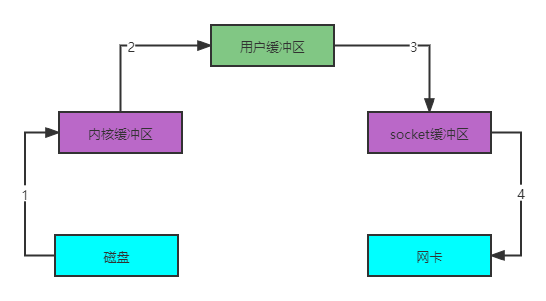
-
java本身并不具备IO读写能力,因此read方法调用后,要从java程序的
用户态切换至内核态,去调用操作系统(Kernel)的读能力,将数据读入内核缓冲区。这期间用户线程阻塞,操作系统使用DMA(Direct Memory Access)来实现文件读,其间也不会使用cpuDMA可以理解为硬件单元,用来解放cpu完成文件IO
-
从
内核态切换回用户态,将数据从内核缓冲区读入用户缓冲区(即 byte[] buf),这期间cpu会参与拷贝,无法利用DMA -
调用write方法,这时将数据从
用户缓冲区(byte[] buf)写入socket 缓冲区,cpu会参与拷贝 -
接下来要向网卡写数据,这项能力java又不具备,因此又得从
用户态切换至内核态,调用操作系统的写能力,使用DMA将socket 缓冲区的数据写入网卡,不会使用cpu
可以看到中间环节较多,java 的 IO 实际不是物理设备级别的读写,而是缓存的复制,底层的真正读写是操作系统来完成的
- 用户态与内核态的切换发生了 3 次,这个操作比较重量级
- 数据拷贝了共 4 次
NIO 优化
通过ByteBuffer.allocateDirect(capacity) 创建DirectByteBuffer使用的是操作系统内存。DirectByteBuf将堆外内存映射到jvm内存中来直接访问使用,
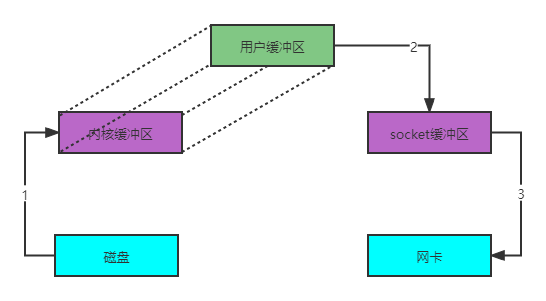
- 这块内存不受 jvm 垃圾回收的影响,因此内存地址固定,有助于 IO 读写
- java 中的 DirectByteBuf 对象仅维护了此内存的虚引用,内存回收分成两步
- DirectByteBuf 对象被垃圾回收,将虚引用加入引用队列
- 通过专门线程访问引用队列,根据虚引用释放堆外内存
- 减少了一次数据拷贝,用户态与内核态的切换次数没有减少
进一步优化(底层采用了linux 2.1后提供的sendFile方法),java 中对应着两channel调用transferTo/transferFrom方法拷贝数据
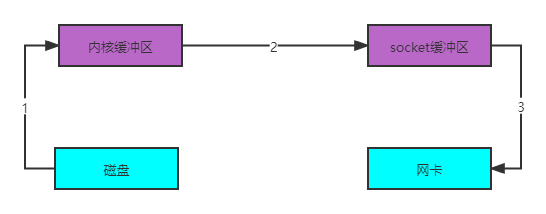
- java调用transferTo方法后,要从java程序的
用户态切换至内核态,使用 DMA将数据读入内核缓冲区,不会使用 cpu - 数据从
内核缓冲区传输到socket 缓冲区,cpu会参与拷贝 - 最后使用DMA将
socket 缓冲区的数据写入网卡,不会使用 cpu
只发生了一次用户态与内核态的切换,数据拷贝了 3 次
进一步优化(linux 2.4)

- java调用transferTo方法后,要从java程序的
用户态切换至内核态,使用DMA将数据读入内核缓冲区,不会使用 cpu - 只会将一些offset和length信息拷入
socket 缓冲区,几乎无消耗 - 使用DMA将
内核缓冲区的数据写入网卡,不会使用 cpu
整个过程仅只发生了一次用户态与内核态的切换,数据拷贝了 2 次。
所谓的【零拷贝】,并不是真正无拷贝,而是在不会拷贝重复数据到 jvm 内存中
NIO vs BIO
stream vs channel
- stream不会自动缓冲数据,channel会利用系统提供的发送缓冲区、接收缓冲区(更为底层)
- stream仅支持阻塞API,channel同时支持阻塞、非阻塞API,网络channel可配合selector实现多路复用
- 二者均为全双工,即读写可以同时进行
IO 模型
同步阻塞、同步非阻塞、同步多路复用、异步阻塞(没有此情况)、异步非阻塞
- 同步:线程自己去获取结果(一个线程)
- 异步:线程自己不去获取结果,而是由其它线程送结果(至少两个线程)
二、Netty的基本使用
简介
Netty是一个异步的、基于事件驱动的网络应用框架,用于快速开发可维护、高性能的网络服务器和客户端。
Netty vs NIO的优势
- NIO,工作量大,bug 多
- NIO需要自己构建协议
- Netty解决TCP传输问题,如粘包、半包
- NIO的epoll空轮询导致CPU100%
- 对API进行增强,使之更易用
最基础的Netty示例
- 服务器端
@Test
public void simpleServerTest() throws IOException {
new ServerBootstrap()
// 创建 NioEventLoopGroup,可以简单理解为 线程池 + Selector
.group(new NioEventLoopGroup())
// 选择服务Socket实现类,其中NioServerSocketChannel表示基于NIO的服务器端实现
.channel(NioServerSocketChannel.class)
// childHandler添加的处理器都是给SocketChannel用的,而不是给ServerSocketChannel
// ChannelInitializer处理器(仅执行一次),它的作用是待客户端SocketChannel建立连接后,执行initChannel以便添加更多的处理器
.childHandler(new ChannelInitializer<NioSocketChannel>() {
protected void initChannel(NioSocketChannel ch) {
// SocketChannel 的处理器,解码 ByteBuf => String
ch.pipeline().addLast(new StringDecoder());
// SocketChannel 的业务处理器,使用上一个处理器的处理结果
ch.pipeline().addLast(new SimpleChannelInboundHandler<String>() {
@Override
protected void channelRead0(ChannelHandlerContext ctx, String msg) {
System.out.println(msg);
}
});
}
})
// 绑定的监听端口
.bind(8080);
System.in.read();
}
- 客户端
@Test
public void simpleClientTest() throws IOException, InterruptedException {
ChannelFuture client = new Bootstrap()
// 创建 NioEventLoopGroup,可以简单理解为 线程池 + Selector
.group(new NioEventLoopGroup())
// 选择服务Socket实现类,其中NioSocketChannel表示基于NIO的客户器端实现
.channel(NioSocketChannel.class)
// ChannelInitializer处理器(仅执行一次),它的作用是待客户端SocketChannel建立连接后,执行initChannel以便添加更多的处理器
.handler(new ChannelInitializer<NioSocketChannel>() {
protected void initChannel(NioSocketChannel ch) {
// SocketChannel 的处理器,编码 ByteBuf => String
ch.pipeline().addLast(new StringEncoder());
}
// 连接服务器
}).connect(new InetSocketAddress(8080));
// Future是异步的,要等待连接上服务器
client.sync();
// 发送数据
client.channel().writeAndFlush("Hello world");
System.in.read();
}
相关概念
需要树立正确的理解观念
- 把 channel 理解为数据的通道
- 把 msg 理解为流动的数据,最开始输入是 ByteBuf,但经过 pipeline 的加工,会变成其它类型对象,最后输出又变成 ByteBuf
- 把 handler 理解为数据的处理工序
- 工序有多道,合在一起就是pipeline,pipeline负责发布事件(读、读取完成…)传播给每个handler, handler对自己感兴趣的事件进行处理(重写了相应事件处理方法)
- handler分Inbound和Outbound两类
- 把 eventLoop 理解为处理数据的工人
- 工人可以管理多个channel的io操作,并且一旦工人负责了某个 channel,就要负责到底(绑定)
- 工人既可以执行io操作,也可以进行任务处理,每位工人有任务队列,队列里可以堆放多个channel的待处理任务,任务分为普通任务、定时任务
- 工人按照pipeline顺序,依次按照handler的规划(代码)处理数据,可以为每道工序指定不同的工人
EventLoop组件
EventLoop【时间循环对象】
本质是一个单线程执行器(同时维护了一个Selector),里面有run方法处理Channel上源源不断的io事件
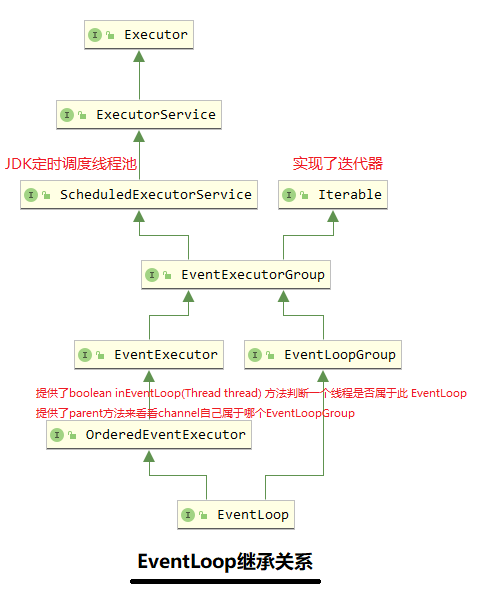
EventLoopGroup【事件循环组】
EventLoopGroup是一组EventLoop,Channel一般会调用EventLoopGroup的register方法来绑定其中一个EventLoop,后续这个Channel上的io事件都由此 EventLoop来处理(保证了io事件处理时的线程安全),有next方法获取集合中下一个EventLoop
// 简单的示例
DefaultEventLoopGroup group = new DefaultEventLoopGroup(2);
System.out.println(group.next()); //io.netty.channel.DefaultEventLoop@60f82f98
System.out.println(group.next()); //io.netty.channel.DefaultEventLoop@35f983a6
System.out.println(group.next()); //io.netty.channel.DefaultEventLoop@60f82f98
// 也可以是有for循环
DefaultEventLoopGroup group = new DefaultEventLoopGroup(2);
for (EventExecutor eventLoop : group) {
System.out.println(eventLoop);
}
优雅关闭
优雅关闭 shutdownGracefully 方法。该方法会首先切换 EventLoopGroup 到关闭状态从而拒绝新的任务的加入,然后在任务队列的任务都处理完成后,停止线程的运行。从而确保整体应用是在正常有序的状态下退出。
@Test
public void simpleClientTest() throws IOException, InterruptedException {
NioEventLoopGroup eventLoopGroup = new NioEventLoopGroup();
ChannelFuture client = new Bootstrap()
.group(eventLoopGroup)
.channel(NioSocketChannel.class)
.handler(new ChannelInitializer<NioSocketChannel>() {
protected void initChannel(NioSocketChannel ch) {
ch.pipeline().addLast(new StringEncoder());
}
}).connect(new InetSocketAddress(8080));
client.sync();
client.channel().writeAndFlush("Hello world");
// 优雅关闭
eventLoopGroup.shutdownGracefully().sync();
}
eventLoop和channel强绑定
关键代码 io.netty.channel.AbstractChannelHandlerContext#invokeChannelRead()
static void invokeChannelRead(final AbstractChannelHandlerContext next, Object msg) {
final Object m = next.pipeline.touch(ObjectUtil.checkNotNull(msg, "msg"), next);
// 下一个 handler 的事件循环是否与当前的事件循环是同一个线程
EventExecutor executor = next.executor();
// 是,直接调用
if (executor.inEventLoop()) {
next.invokeChannelRead(m);
}
// 不是,将要执行的代码作为任务提交给下一个事件循环处理(换人)
else {
executor.execute(new Runnable() {
@Override
public void run() {
next.invokeChannelRead(m);
}
});
}
}
Channel组件
channel的主要作用
- close() 可以用来关闭channel
- closeFuture() 用来处理channel的关闭
- sync方法作用是同步等待channel关闭
- 而addListener方法是异步等待channel关闭
- pipeline() 方法添加处理器
- write() 方法将数据写入
- writeAndFlush() 方法将数据写入并刷出
ChannelFuture
public void simpleClientTest() throws IOException, InterruptedException {
NioEventLoopGroup eventLoopGroup = new NioEventLoopGroup();
ChannelFuture client = new Bootstrap()
.group(eventLoopGroup)
.channel(NioSocketChannel.class)
.handler(new ChannelInitializer<NioSocketChannel>() {
protected void initChannel(NioSocketChannel ch) {
ch.pipeline().addLast(new StringEncoder());
}
}).connect(new InetSocketAddress(8080));
// connect方法是异步的,意味着不等连接建立,方法执行就返回了。
// 因此channelFuture对象中不能【立刻】获得到正确的Channel对象
client.sync();
// 返回的是ChannelFuture对象,它的作用是利用channel()方法来获取Channel对象
client.channel().writeAndFlush("Hello world");
ChannelFuture channelFuture = client.channel().closeFuture();
// 可执行channel关闭后的扫尾操作
channelFuture.addListener(new GenericFutureListener<Future<? super Void>>() {
@Override
public void operationComplete(Future<? super Void> future) throws Exception {
System.out.println("关闭后扫尾操作");
}
});
eventLoopGroup.shutdownGracefully().sync();
}
异步的好处
举个例子,如果4个医生同步处理看病的全流程,则会是如下,假设挂号、取药10min,看病、缴费20min,则60min能走完4个病人看病流程
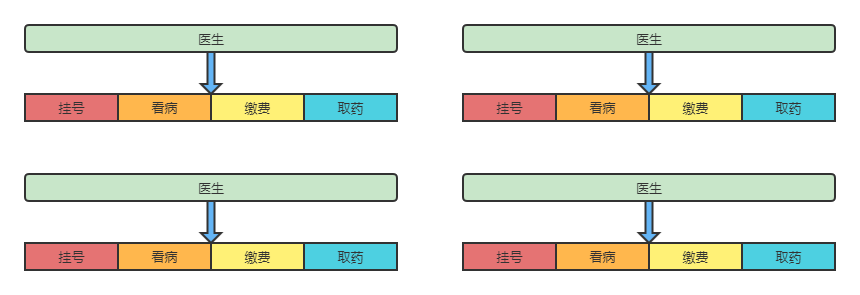
如果改为异步,则60min,可以处理6个挂号,6个取药,3个看病,3个缴费。这样挂号数量上升会使吞吐量上升。单实际看完的病人数量会下降。

- 单线程没法异步提高效率,必须配合多线程、多核 cpu 才能发挥异步的优势
- 异步并没有缩短响应时间,反而有所增加,提高的是吞吐量
- 合理进行任务拆分,也是利用异步的关键
Future & Promise
在异步处理时,经常用到这两个接口
首先要说明netty中的Future与jdk中的Future同名,但是是两个接口,netty的Future继承自jdk的Future,而Promise又对netty Future进行了扩展
- jdk Future只能同步等待任务结束(或成功、或失败)才能得到结果
- netty Future可以同步等待任务结束得到结果,也可以异步方式得到结果,但都是要等任务结束
- netty Promise不仅有netty Future的功能,而且脱离了任务独立存在,只作为两个线程间传递结果的容器
| 功能/名称 | jdk Future | netty Future | Promise |
|---|---|---|---|
| cancel | 取消任务 | - | - |
| isCanceled | 任务是否取消 | - | - |
| isDone | 任务是否完成,不能区分成功失败 | - | - |
| get | 获取任务结果,阻塞等待 | - | - |
| getNow | - | 获取任务结果,非阻塞,还未产生结果时返回 null | - |
| await | - | 等待任务结束,如果任务失败,不会抛异常,而是通过isSuccess判断 | - |
| sync | - | 等待任务结束,如果任务失败,抛出异常 | - |
| isSuccess | - | 判断任务是否成功 | - |
| cause | - | 获取失败信息,非阻塞,如果没有失败,返回null | - |
| addLinstener | - | 添加回调,异步接收结果 | - |
| setSuccess | - | - | 设置成功结果 |
| setFailure | - | - | 设置失败结果 |
示例
// ==================================== 同步处理任务成功 ====================================
public void syncSuccessTest() throws ExecutionException, InterruptedException {
DefaultEventLoop eventExecutors = new DefaultEventLoop();
DefaultPromise<Integer> promise = new DefaultPromise<>(eventExecutors);
eventExecutors.execute(()->{
try {
Thread.sleep(1000);
} catch (InterruptedException e) {
e.printStackTrace();
}
log.info("set success, {}",10);
promise.setSuccess(10);
});
log.info("start...");
log.info("getNow = {}",promise.getNow()); // 还没有结果
log.info("get = {}",promise.get());
}
// ==================================== 异步处理任务成功 ====================================
public void asyncSuccessTest() throws ExecutionException, InterruptedException {
DefaultEventLoop eventExecutors = new DefaultEventLoop();
DefaultPromise<Integer> promise = new DefaultPromise<>(eventExecutors);
// 设置回调,异步接收结果
promise.addListener(future -> {
log.info("getNow = {}", future.getNow());
});
// 等待 1000 后设置成功结果
eventExecutors.execute(() -> {
try {
Thread.sleep(1000);
} catch (InterruptedException e) {
e.printStackTrace();
}
log.info("set success, {}", 10);
promise.setSuccess(10);
});
log.info("start...");
promise.await();
}
Handler & Pipeline
ChannelHandler用来处理Channel上的各种事件,分为入站、出站两种。所有ChannelHandler被连成一串,就是Pipeline
- 入站处理器通常是ChannelInboundHandlerAdapter的子类,主要用来读取客户端数据,写回结果
- 出站处理器通常是ChannelOutboundHandlerAdapter的子类,主要对写回结果进行加工
ChannelInboundHandlerAdapter是按照addLast的顺序执行的,而ChannelOutboundHandlerAdapter是按照addLast的逆序执行的。ChannelPipeline的实现是一个ChannelHandlerContext(包装了 ChannelHandler)组成的双向链表

读取消息执行顺序:Head -> In_1 -> In_2 -> Out_1(不处理)-> Out_2(不处理)-> Tail
发送消息执行顺序:Tail -> Out_2 -> Out_1 -> In_2 (不处理)-> In_1 (不处理)-> Head
chx.writeAndFlush是从当前位置向Head返回发送数据
ch.writeAndFlush是从Tail向Head返回发送数据,如果是在ChannelOutboundHandlerAdapte进行会是死循环
ByteBuf
是对字节数据的封装,提供了比NIO ByteBuffer更好的使用体验
调试准备
private static void log(ByteBuf buffer) {
int length = buffer.readableBytes();
int rows = length / 16 + (length % 15 == 0 ? 0 : 1) + 4;
StringBuilder buf = new StringBuilder(rows * 80 * 2)
.append("read index:").append(buffer.readerIndex())
.append(" write index:").append(buffer.writerIndex())
.append(" capacity:").append(buffer.capacity())
.append(" class:").append(buffer.getClass())
.append(NEWLINE);
ByteBufUtil.appendPrettyHexDump(buf, buffer);
System.out.println(buf.toString());
}
1)创建
@Test
public void byteBufTest() {
// 默认创建的是池化的直接内存
ByteBuf buffer = ByteBufAllocator.DEFAULT.buffer(10);
// read index:0 write index:0 capacity:10 class:class io.netty.buffer.PooledUnsafeDirectByteBuf
log(buffer);
}
2)直接内存 vs 堆内存
可以使用下面的代码来创建池化基于堆的 ByteBuf
ByteBuf buffer = ByteBufAllocator.DEFAULT.heapBuffer(10);
也可以使用下面的代码来创建池化基于直接内存的 ByteBuf
ByteBuf buffer = ByteBufAllocator.DEFAULT.directBuffer(10);
- 直接内存创建和销毁的代价昂贵,但读写性能高(少一次内存复制),适合配合池化功能一起用
- 直接内存对 GC 压力小,因为这部分内存不受 JVM 垃圾回收的管理,但也要注意及时主动释放
3)池化 vs 非池化
池化的最大意义在于可以重用 ByteBuf,优点有
- 没有池化,则每次都得创建新的 ByteBuf 实例,这个操作对直接内存代价昂贵,就算是堆内存,也会增加 GC 压力
- 有了池化,则可以重用池中 ByteBuf 实例,并且采用了与 jemalloc 类似的内存分配算法提升分配效率
- 高并发时,池化功能更节约内存,减少内存溢出的可能
池化功能是否开启,可以通过系统环境变量来设置-Dio.netty.allocator.type={unpooled|pooled}
- 4.1 以后,非 Android 平台默认启用池化实现,Android 平台启用非池化实现
- 4.1 之前,池化功能还不成熟,默认是非池化实现
4)组成
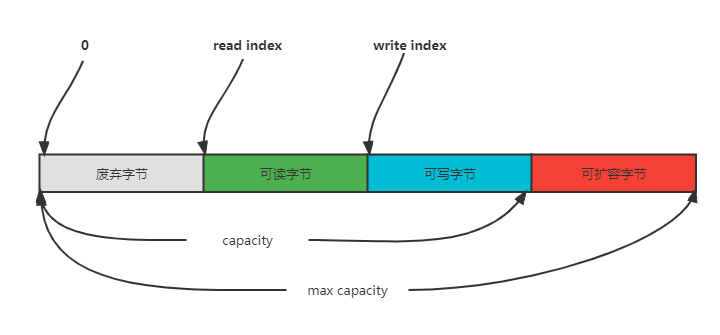
5)写入
| 方法签名 | 含义 | 备注 |
|---|---|---|
| writeBoolean(boolean value) | 写入 boolean 值 | 用一字节 01|00 代表 true|false |
| writeByte(int value) | 写入 byte 值 | |
| writeShort(int value) | 写入 short 值 | |
| writeInt(int value) | 写入 int 值 | Big Endian,即 0x250,写入后 00 00 02 50 |
| writeIntLE(int value) | 写入 int 值 | Little Endian,即 0x250,写入后 50 02 00 00 |
| writeLong(long value) | 写入 long 值 | |
| writeChar(int value) | 写入 char 值 | |
| writeFloat(float value) | 写入 float 值 | |
| writeDouble(double value) | 写入 double 值 | |
| writeBytes(ByteBuf src) | 写入 netty 的 ByteBuf | |
| writeBytes(byte[] src) | 写入 byte[] | |
| writeBytes(ByteBuffer src) | 写入 nio 的 ByteBuffer | |
| int writeCharSequence(CharSequence sequence, Charset charset) | 写入字符串 |
6)扩容
ByteBuf具有自动扩容能力,规则是
- 如何写入后数据大小未超过 512,则选择下一个16的整数倍,例如写入后大小为12 ,则扩容后capacity是16
- 如果写入后数据大小超过512,则选择下一个 2^n,例如写入后大小为513,则扩容后 capacity是2^10=1024(2^9=512 已经不够了)
- 扩容不能超过max capacity否则报错
7)读取
@Test
public void byteBufReadTest() {
ByteBuf buffer = ByteBufAllocator.DEFAULT.buffer(10);
buffer.writeBytes("ABCDEFG".getBytes());
// 读取,影响读指针
System.out.println((char)buffer.readByte()); // A
System.out.println((char)buffer.readByte()); // B
System.out.println((char)buffer.readByte()); // C
System.out.println((char)buffer.readByte()); // D
// mark标记读指针
buffer.markReaderIndex();
System.out.println((char)buffer.readByte()); // E
System.out.println((char)buffer.readByte()); // F
// 读指针复位
buffer.resetReaderIndex();
System.out.println((char)buffer.readByte()); // E
// get方法不影响指针
System.out.println((char)buffer.getByte(0)); // A
}
8)retain & release
由于Netty中有堆外内存的ByteBuf实现,堆外内存最好是手动来释放,而不是等GC垃圾回收
- UnpooledHeapByteBuf 使用的是 JVM 内存,只需等 GC 回收内存即可
- UnpooledDirectByteBuf 使用的就是直接内存了,需要特殊的方法来回收内存
- PooledByteBuf 和它的子类使用了池化机制,需要更复杂的规则来回收内存
Netty 这里采用了引用计数法来控制回收内存,每个 ByteBuf 都实现了 ReferenceCounted 接口
- 每个ByteBuf对象的初始计数为 1
- 调用release方法计数减 1,如果计数为0,ByteBuf内存被回收
- 调用retain方法计数加 1,表示调用者没用完之前,其它handler即使调用了release也不会造成回收
- 当计数为0时,底层内存会被回收,这时即使ByteBuf对象还在,其各个方法均无法正常使用
因为pipeline的存在,一般需要将ByteBuf传递给下一个ChannelHandler,所以基本规则是,谁是最后使用者,谁负责 release,即TailContext负责释放
9)slice
【零拷贝】的体现之一,对原始ByteBuf进行切片成多个ByteBuf,还是使用原始ByteBuf的内存,切片后的ByteBuf维护独立的read,write指针
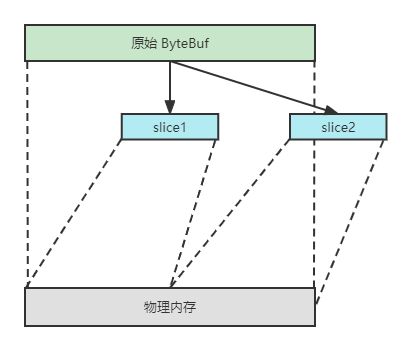
10)duplicate
【零拷贝】的体现之一,截取了原始ByteBuf所有内容,并且没有max capacity的限制,也是与原始ByteBuf使用同一块底层内存,只是读写指针是独立的
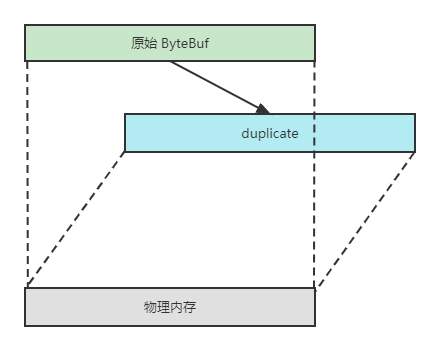
11)copy
会将底层内存数据进行深拷贝,因此无论读写,都与原始 ByteBuf 无关
12)CompositeByteBuf
【零拷贝】的体现之一,将多个ByteBuf合并为一个逻辑上的ByteBuf,避免拷贝。CompositeByteBuf是一个组合的ByteBuf,它内部维护了一个Component数组,每个Component管理一个ByteBuf,记录了这个ByteBuf 相对于整体偏移量等信息,代表着整体中某一段的数据。
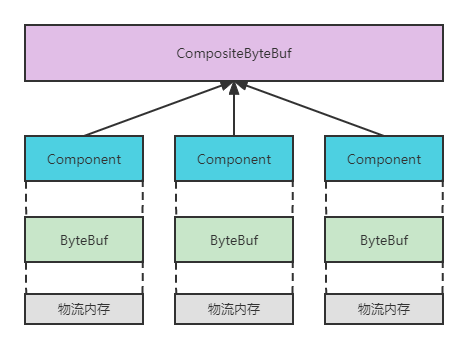
13)Unpooled
Unpooled 是一个工具类,类如其名,提供了非池化的 ByteBuf 创建、组合、复制等操作
@Test
public void byteBufUnpooledTest() {
ByteBuf buffer1 = Unpooled.buffer(10);
buffer1.release();
ByteBuf buffer2 = Unpooled.buffer(10);
buffer2.release();
// false
System.out.println(buffer1 == buffer2);
ByteBuf buffer3 = ByteBufAllocator.DEFAULT.buffer(10);
buffer3.release();
ByteBuf buffer4 = ByteBufAllocator.DEFAULT.buffer(10);
buffer4.release();
// true
System.out.println(buffer3 == buffer4);
}
ByteBuf 优势
- 池化 - 可以重用池中 ByteBuf 实例,更节约内存,减少内存溢出的可能
- 读写指针分离,不需要像 ByteBuffer 一样切换读写模式
- 可以自动扩容
- 支持链式调用,使用更流畅
- 很多地方体现零拷贝,例如 slice、duplicate、CompositeByteBuf
三、Netty高级用法
粘包与半包
粘包和半包的现象是消息边界的另一种说法
粘包
- 现象:发送 abc def,接收 abcdef
- 原因
- 应用层:接收方ByteBuf设置太大(Netty默认1024)
- 滑动窗口:假设发送方256bytes表示一个完整报文,但由于接收方处理不及时且窗口大小足够大,这256bytes 字节就会缓冲在接收方的滑动窗口中,当滑动窗口中缓冲了多个报文就会粘包
- Nagle算法:会造成粘包
半包
- 现象:发送 abcdef,接收 abc def
- 原因
- 应用层:接收方ByteBuf小于实际发送数据量
- 滑动窗口:假设接收方的窗口只剩了128bytes,发送方的报文大小是256bytes,这时放不下了,只能先发送前128bytes,等待ack后才能发送剩余部分,这就造成了半包
- MSS限制:当发送的数据超过MSS限制后,会将数据切分发送,就会造成半包
Nagle 算法
即使发送一个字节,也需要加入tcp头和ip头,也就是总字节数会使用41bytes,非常不经济。因此为了提高网络利用率,tcp希望尽可能发送足够大的数据,这就是 Nagle 算法产生的缘由,该算法是指发送端即使还有应该发送的数据,但如果这部分数据很少的话,则进行延迟发送
MSS限制
MSS的值在三次握手时通知对方自己MSS的值【网卡的传输能力】,然后在两者之间选择一个小值作为MSS
Netty解决的途径
固定长度
让所有数据包长度固定
ch.pipeline().addLast(new FixedLengthFrameDecoder(8));
缺点:
- 长度定的太大,浪费
- 长度定的太小,对某些数据包又显得不够
固定分隔符
服务端加入,默认以\n或\r\n作为分隔符,如果超出指定长度仍未出现分隔符,则抛出异常
ch.pipeline().addLast(new LineBasedFrameDecoder(1024));
缺点:处理字符数据比较合适,但如果内容本身包含了分隔符(字节数据常常会有此情况),那么就会解析错误
预设长度
// 最大长度,长度偏移,长度占用字节,长度调整,剥离字节数
ch.pipeline().addLast(new LengthFieldBasedFrameDecoder(1024, 0, 1, 0, 1));
心跳机制
可以使用IdleStateHandler发送心跳,也可以自定义发送心跳
/**
* readerIdleTime 读空闲时间
* writerIdleTime 写空闲时间
* allIdleTime 所有空闲时间
* unit 时间单位
*/
pipeline.addLast(new IdleStateHandler(0, 5, 0, TimeUnit.SECONDS));
编码
Netty编解码技术(就是指序列化传递对象),我们可以使用Java进行对象序列化,netty去传输,但是Java序列化没法跨语言,存在序列化后的码流太大,序列化性能太低等。
主流的编解码框架
- JBoss的Marshalling
- google的ProtoBuf
- 基于Protobuf的Kyro
- MessagePack框架
//======================================= 集成Marshalling =======================================
public class MarshallingCodeFactory {
public static MarshallingDecoder bulidMarshallingDecoder(){
//首先通过Marshalling工具类获取Marshalling实例对象,参数serial标识创建的是java序列化工厂对象
MarshallerFactory marshallerFactory = Marshalling.getProvidedMarshallerFactory("serial");
//创建了MarshallingConfiguration对象,配置版本号为5
MarshallingConfiguration configuration = new MarshallingConfiguration();
configuration.setVersion(5);
//根据marshallerFactory好Configuration创建provider
UnmarshallerProvider provider = new DefaultUnmarshallerProvider(marshallerFactory, configuration);
//构建Netty的MarshallingDecoder对象,俩个参数分别为provider和单个消息序列化后的最大长度
MarshallingDecoder decoder = new MarshallingDecoder(provider, 1024*1024);
return decoder;
}
public static MarshallingEncoder bulidMarshallingEncoder(){
MarshallerFactory marshallerFactory = Marshalling.getProvidedMarshallerFactory("serial");
MarshallingConfiguration configuration = new MarshallingConfiguration();
configuration.setVersion(5);
MarshallerProvider provider = new DefaultMarshallerProvider(marshallerFactory, configuration);
MarshallingEncoder encoder = new MarshallingEncoder(provider);
return encoder;
}
}
/**
* 客户端和服务器都加上Marshalling编解码器
*/
protected void initChannel(SocketChannel ch) throws Exception {
//注意顺序
ch.pipeline().addLast(MarshallingCodeFactory.bulidMarshallingDecoder());
ch.pipeline().addLast(MarshallingCodeFactory.bulidMarshallingEncoder());
//...
}
Netty提供的主要TCP参数
| 参数 | 解释 |
|---|---|
| SO_TIMEOUT | 控制读取操作将阻塞多少毫秒。如果返回值为0,计时器就被禁止了,该线程将无限期阻塞 |
| SO_SNDBUF | 套接字使用的发送缓冲区大小 |
| SO_RCVBUF | 套接字使用的接收缓冲区大小 |
| CONNECTTIMEOUTMILLIS | 客户端连接超时时间,由于NIO原生的客户端并不提供设置连接超时的接口。 因此,Netty采用的是自定义连接超时定时器负责检测和超时控制 |
| TCPNODELAY | 激活或禁止TCPNODELAY套接字选项,它决定是否使用Nagle算法。如果是时延敏感型的应用,建议关闭Nagle算法 |